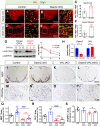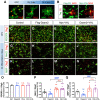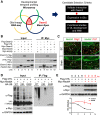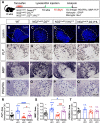The Daam2-VHL-Nedd4 axis governs developmental and regenerative oligodendrocyte differentiation
- PMID: 32792353
- PMCID: PMC7462057
- DOI: 10.1101/gad.338046.120
The Daam2-VHL-Nedd4 axis governs developmental and regenerative oligodendrocyte differentiation
Abstract
Dysregulation of the ubiquitin-proteasomal system (UPS) enables pathogenic accumulation of disease-driving proteins in neurons across a host of neurological disorders. However, whether and how the UPS contributes to oligodendrocyte dysfunction and repair after white matter injury (WMI) remains undefined. Here we show that the E3 ligase VHL interacts with Daam2 and their mutual antagonism regulates oligodendrocyte differentiation during development. Using proteomic analysis of the Daam2-VHL complex coupled with conditional genetic knockout mouse models, we further discovered that the E3 ubiquitin ligase Nedd4 is required for developmental myelination through stabilization of VHL via K63-linked ubiquitination. Furthermore, studies in mouse demyelination models and white matter lesions from patients with multiple sclerosis corroborate the function of this pathway during remyelination after WMI. Overall, these studies provide evidence that a signaling axis involving key UPS components contributes to oligodendrocyte development and repair and reveal a new role for Nedd4 in glial biology.
Keywords: CNS development; multiple sclerosis; oligodendrocyte; remyelination.
© 2020 Ding et al.; Published by Cold Spring Harbor Laboratory Press.
Figures







References
-
- Amodio N, Scrima M, Palaia L, Salman AN, Quintiero A, Franco R, Botti G, Pirozzi P, Rocco G, De Rosa N, et al. 2010. Oncogenic role of the E3 ubiquitin ligase NEDD4-1, a PTEN negative regulator, in non-small-cell lung carcinomas. Am J Pathol 177: 2622–2634. 10.2353/ajpath.2010.091075 - DOI - PMC - PubMed
Publication types
MeSH terms
Substances
Grants and funding
LinkOut - more resources
Full Text Sources
Medical
Molecular Biology Databases
